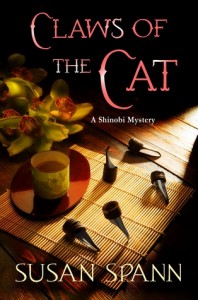 Format read: ebook provided by NetGalley
Format read: ebook provided by NetGalleyFormats available: ebook, hardcover
Genre: historical mystery
Series: Shinobi Mystery, #1
Length: 288 pages
Publisher: Minotaur Books
Date Released: July 16, 2013
Purchasing Info: Author’s Website, Publisher’s Website, Goodreads, Amazon, Barnes & Noble, Kobo, Book Depository
May 1564: When a samurai is brutally murdered in a Kyoto teahouse, master ninja Hiro has no desire to get involved. But the beautiful entertainer accused of the crime enlists the help of Father Mateo, the Portuguese Jesuit Hiro is sworn to protect, leaving the master shinobi with just three days to find the killer in order to save the girl and the priest from execution.
The investigation plunges Hiro and Father Mateo into the dangerous waters of Kyoto’s floating world, where they learn that everyone from the elusive teahouse owner to the dead man’s dishonored brother has a motive to keep the samurai’s death a mystery. A rare murder weapon favored by ninja assassins, a female samurai warrior, and a hidden affair leave Hiro with too many suspects and far too little time. Worse, the ninja’s investigation uncovers a host of secrets that threaten not only Father Mateo and the teahouse, but the very future of Japan.
My Review:
This was awesome. Full stop. The setting is unusual and the detectives are surprising and possibly unique. The mystery is intricate and it is marvelous to play along with a mystery that doesn’t (and can’t) rely on modern forensics. It’s all down to human ingenuity and human intelligence.
Also, of course, human greed.
The story takes place in 16th Japan, during the years known as the Warring States period. This was a period when rival clans were attempting, and often succeeding, in capturing the Shogunate by military might as well as subterfuge.
It was also the period when Japan was only open to Westerners on a relatively limited and controlled basis. The Japanese were not certain of the traders, and especially the Catholic missionaries, motives for wanting to be in Japan.
So our protagonists in this mystery are a Catholic priest and missionary, Father Mateo, and his bodyguard Hiro. At first, it seems as if Father Mateo is the leader in this surprising partnership, but in fact, it is Hiro who moves the investigation. While Father Mateo is exactly as he seems, Hiro is very little of who he appears to be, by intention and not accident.
Hiro is a shinobi, what we would call a ninja. He is a master of shadows. But his life is bound to protect Father Mateo, which drags him along when the priest deliberately or accidently puts his foot into it.
Mysteries are often investigated by outsiders, and in this case, we have two; the Catholic priest living both in and outside the strict Japanese culture, and the shinobi, who is always an outsider in his own land, seeking out every enemy and searching for every exit.
The crime seems simple at first. A retired general is murdered in a respectable teahouse, and an entertainer is found by his side, covered in his blood. It’s an open and shut case, until the entertainer asks for Father Mateo. She is a Christian convert and wants the priest to pray for her. Or with her.
But Mateo believes that she is innocent of the crime, and interferes with the general’s son’s right to have revenge on his father’s murderer. The son, being a hot-headed and privileged idiot, makes Father Mateo responsible for finding the real killer, or dying with young woman he defends.
Hiro is forced into the investigation, as he is bound by his own honor to keep Father Mateo alive, even at the cost of his own life. If Mateo is killed, Hiro will be required to die with him.
And so the reader is immersed in the “Floating World” of the Japanese teahouses, the simmering pot of medieval Japanese politics, and the strict code of honor that is Bushido, the way of the warrior.
As Father Mateo blunders through the thickets of a society that he has been on the fringes of and is still trying to understand, Mateo navigates deeper waters, while following the oldest clue of mysteries everywhere, “who benefits?”
The answer will surprise you, but the journey will bring delights and insights in equally marvelous measure.
Escape Rating A: In a surprising way, Claws of the Cat reminded me of Ellis Peters’ Brother Cadfael mysteries. As we read, we are steeped in a world that has small shocks of familiarity in the midst of astonishing differences. We think we understand, and then the way the world works surprises us.
There is also the similarity in that Cadfael, like Hiro, has to solve the crime based on his knowledge of the world, his understanding of human nature, but without forensics beyond those observable to the naked eye. The solution is in the intelligence of the detective, and the human failures of the criminals and those around them.
Hiro makes a fascinating detective. His outer appearance is an intentional act, so we discover the bits of himself he chooses to reveal as we walk with him through the story. He, in turn, reveals the world in which he lives, especially as he is an observer no matter where he goes, and does not intend to be a prime mover. In fact, he wants to conceal that he is even capable of being that prime mover. His job is to remain in the shadows.
The plots and counterplots will keep you guessing until the very end. There are political motives, personal motives and purely monetary reasons why this general is dead. The question that Hiro has to answer is which, if any, are the causes for this murder. And whether he can find the answer in time to save Mateo, and himself.
Somewhere, there must be a story about how Mateo and Hiro first meet, and why Hiro is bound to protect Mateo. The hints that Hiro makes regarding his initial contact (and contract) to guard Mateo are quite a tease.







One thought on “Review: Claws of the Cat by Susan Spann”
Comments are closed.